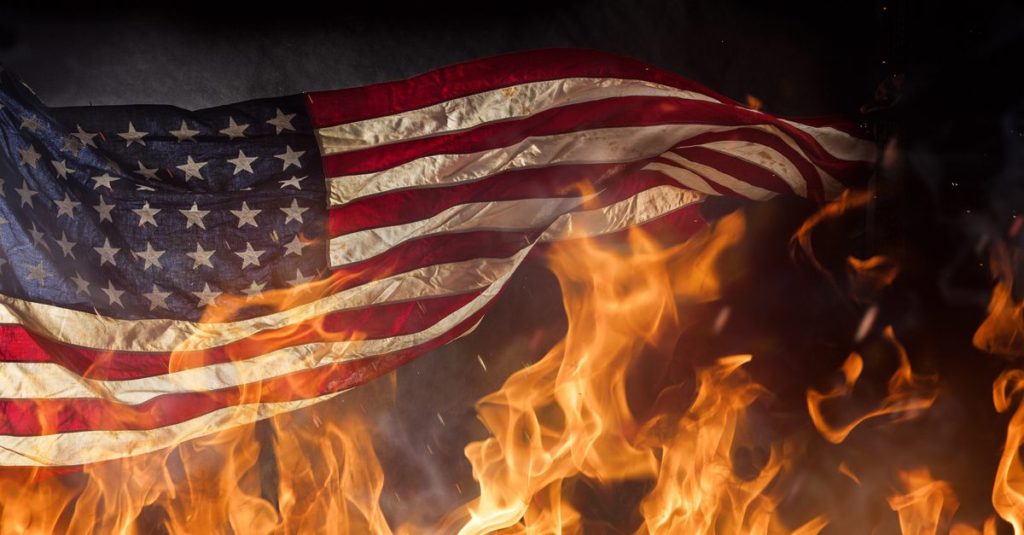All through my public K-12 education I learned popular anthems like “The House I Live In,” “This Is a Great Country,” and “God Bless America,” along with the old standards (“America the Beautiful,” ‘My Country, ‘tis of Thee”). By 1967, though (my junior year), such guileless flag-waving wasn’t cool. I gave a speech against patriotism to the Rotary Club—not too smart, but truth to power and all that.

Patriotism was an outmoded idea, anyway, the cause of unending wars when we had so many problems to solve at home. Racism, the Feminine Mystique, poverty, the military-industrial complex—what was not to complain about? Shortly after came Nixon and Watergate and general “malaise.”
But you know what? Life wasn’t too bad. Most of us had enough food (even though prices were zooming in the 70s), a place to live (with double-digit interest rates, if you chose to buy), the freedom to move around and find another job if you didn’t like the one you had (we did that a lot). My husband had acquired a B.A. degree at tuition rates we could pay off within ten years. That degree that allowed him access to a white-color job once he got the wanderlust out of his system. Our black friends were no longer segregated—that’s why we could have black friends—no more moving to the back of the bus or “colored days” at the State Fair.
Also, I started reading history, and decided this country was actually pretty great after all. A complicated past, to be sure, but with a form of government that allowed for self-correcting over time. There was plenty of ugliness, but also plenty of hope and upward mobility: more than any other nation in history, anywhere on the globe. I grew up in what would now be considered poverty, yet we always had enough to eat and a roof over our heads and free education that actually educated us a little.
But ever since high school, the only time a certain subset of people—which at one time included me—can speak well of the United States is when they are running for office. Then, it’s the land we love, even though it may have lost its way or forgotten its ideals or listened to the wrong people too long. All this great country needed was the right people to get it back on track. That was the vibe from Barak Obama and Bill & Hilary Clinton, though it didn’t always sound like it was coming from the heart.
Joseph R. Biden is different. When he talks about this great country, I think he means it, as someone who started from a humble beginning and achieved the nation’s highest office—“Only in America.” He’s an old-time glad-handing political animal who knows how to work a room but his Inaugural Address came from a genuine core, however deeply buried.
So I don’t get why he’s promoting Critical Race Theory, unless he doesn’t really understand it. The basic premise of CRT is that the United States is founded on racism (not a bug but a feature) and owes its wealth to slavery, all the way up to the present day. Biden has mandated “racial sensitivity training” (a euphemism for CRT) in all federal agencies and disbanded the 1776 Commission established by President Trump, calling it inaccurate and harmful. The 1776 Commission was intended to counteract the negativity embodied by CRT and the 1619 project, etc.—to restore some balance or to whitewash, depending on who’s talking about it.
I haven’t read the 1776 Report and can’t judge the whitewashing content. But I’ve read parts of the 1619 project and I think it’s both inaccurate and harmful. Has President Biden read either? Because if he has, and still buys into CRT, he can’t believe this is a great country. If the United States was founded on racism, what could possibly be great about it? The only solution is to dismantle our constitutional government and rebuild it from the ground up—which is just what some Critical Race theorists would like to do.
I assume that’s not what Joe Biden wants to do, or other patriotic Democrats. But it suggests that the deep division he wants to unify goes through his own heart (to paraphrase Solzhenitsyn). And through the Democratic party’s heart, and through the heart of America as well. If the USA is as bad as the critical theorists say, it’s not worth saving.
Just make up your mind.




 it connects the individual to his community and creates a sense of obligation (as opposed to entitlement). You show up; you do the job; you get paid. Less than half of Americans get jobs while still in their teen years, and when they do enter the work force in their mid-twenties, they don’t seem to know what to expect. I hear about millennials who have to be corrected carefully so as not to ruffle their feathers, and who get frustrated after eight months because they’re not “having an impact.” Then there are those blue-collar dropouts who simply don’t show up.
it connects the individual to his community and creates a sense of obligation (as opposed to entitlement). You show up; you do the job; you get paid. Less than half of Americans get jobs while still in their teen years, and when they do enter the work force in their mid-twenties, they don’t seem to know what to expect. I hear about millennials who have to be corrected carefully so as not to ruffle their feathers, and who get frustrated after eight months because they’re not “having an impact.” Then there are those blue-collar dropouts who simply don’t show up.

